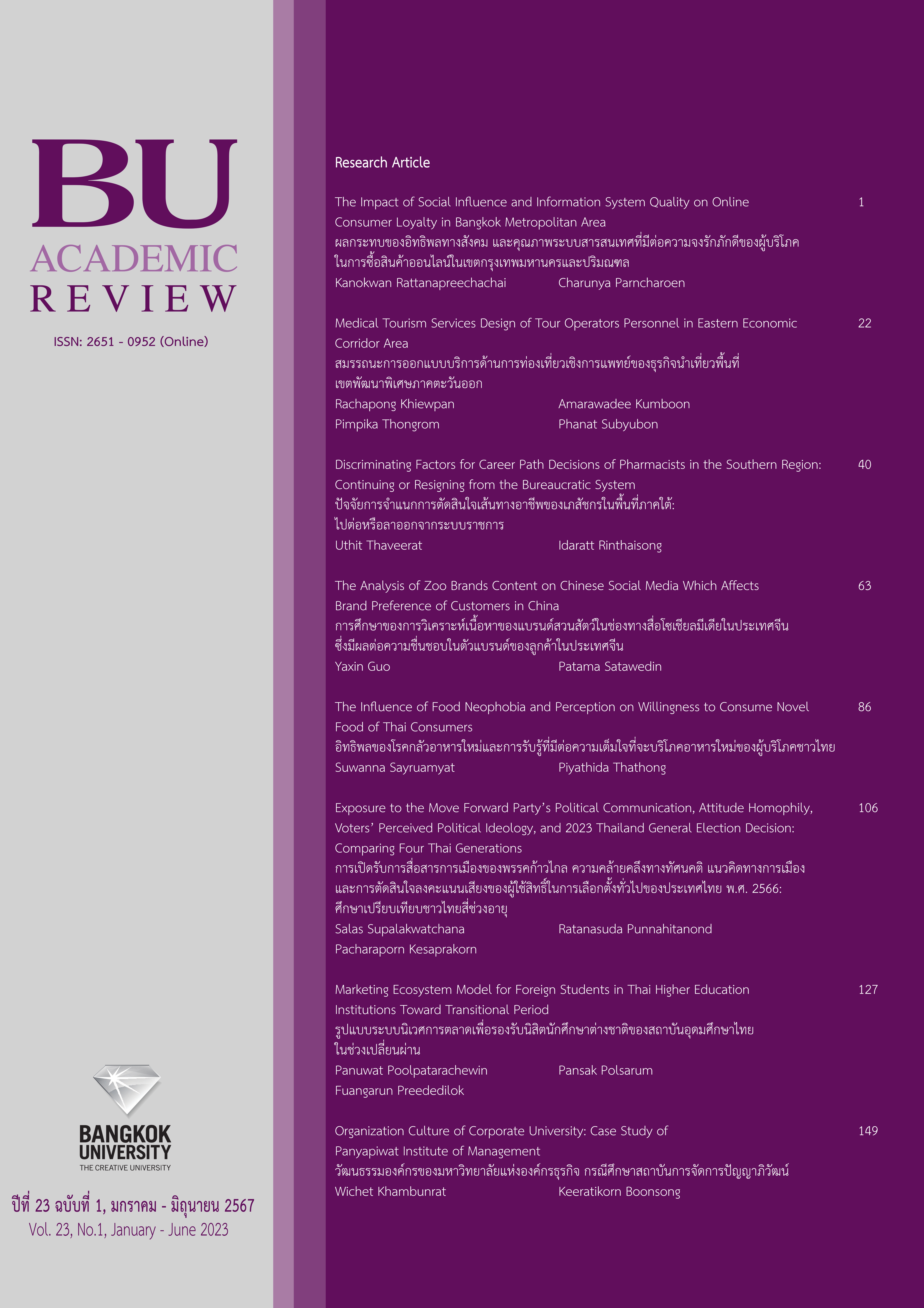สมรรถนะการออกแบบบริการด้านการท่องเที่ยวเชิงการแพทย์ของ ธุรกิจนำเที่ยวพื้นที่เขตพัฒนาพิเศษภาคตะวันออก
Main Article Content
บทคัดย่อ
การบริการของธุรกิจนำเที่ยวมีความสำคัญต่อการท่องเที่ยวเชิงการแพทย์ในเขตพัฒนาพิเศษภูมิภาคตะวันออก (EEC) งานวิจัยนี้จึงต้องการศึกษาการออกแบบบริการด้านการท่องเที่ยวเชิงการแพทย์ของธุรกิจนำเที่ยว ซึ่งเป็นส่วนหนึ่งของห่วงโซ่อุปทานที่ต้องดำเนินการเพื่อตอบสนองต่อความต้องการของนักท่องเที่ยว 2 กิจกรรม คือ บริการการแพทย์และการขนส่ง โดยรวบรวมข้อมูลจากกลุ่มตัวอย่างนักท่องเที่ยวชาวต่างชาติพื้นที่เขตพัฒนาพิเศษภาคตะวันออก ด้วยวิธีการสุ่มตัวอย่างด้วยการเลือกแบบเจาะจง และวิเคราะห์องค์ประกอบเชิงสำรวจ ด้วยวิธีการสกัดปัจจัย หมุนแกนแบบออโธกอนอลด้วยวิธีแวริแมกซ์ ใช้การกำหนดขนาดตัวอย่างจากจำนวนของตัวแปรที่ทำการศึกษา โดยเก็บข้อมูลจากกลุ่มตัวอย่างจำนวน 249 คน ผลการวิจัย พบว่า สามารถจัดกลุ่มตัวแปรที่เกี่ยวข้องกับการบริการการแพทย์ 4 กลุ่ม ความแปรปรวนสะสม 41.322 57.593 69.856 77.420 และเกี่ยวข้องกับบริการการขนส่ง 3 กลุ่ม ความแปรปรวนสะสม 49.264 67.886 78.629 โดยบริการที่นักท่องเที่ยวให้ความสำคัญที่สุดแต่ละกลุ่มประกอบด้วย ความรู้เกี่ยวกับโปรแกรมตรวจสุขภาพ การจัดซื้อจัดหาโปรแกรมตรวจสุขภาพ การดำเนินการและจัดทำเอกสารเพื่อเข้ารับการรักษาในประเทศไทย บริการล่ามแปลภาษา ข้อมูลค่าใช้จ่ายในการเดินทางเพื่อการท่องเที่ยว การจัดหารถพยาบาล และการประสานงานจัดหาบริการรับ-ส่งจากสนามบิน โดยมีค่าน้ำหนักองค์ประกอบ .913 .919 .887 .888 .924 .928 และ .757 ตามลำดับ
Article Details

อนุญาตภายใต้เงื่อนไข Creative Commons Attribution-NonCommercial-NoDerivatives 4.0 International License.
บทความที่นำมาสมัครลงตีพิมพ์ในวารสารต้องไม่เคยได้รับการตีพิมพ์เผยแพร่มาก่อน และไม่ส่งต้นฉบับบทความซ้ำซ้อนกับวารสารอื่น รวมทั้งผู้เขียนบทความต้องไม่ละเมิดหรือคัดลอกผลงานของผู้อื่น
เอกสารอ้างอิง
Abadi, F. A., Sahebi, I. G., Arab, A., Alavi, A., & Karachi, H. (2018). Application of best-worst method
in evaluation of medical tourism development strategy. Decision Science Letters, 7(1), 77-
Abbaspour, A., Rahimian, H., Shaarbafchizadeh, N., Maghari, A., & Danial, Z., (2022). Designing the
competency-based training model of Iranian medical tourism. Journal of Education and
Health Promotion, 11(1), 1-10.
Ajmera, P. (2017). Ranking the strategies for Indian medical tourism sector through the integration
of SWOT analysis and TOPSIS method. International Journal of Health Care Quality
Assurance, 30(8), 668-679.
Alberti, F. G., Giusti, J. D., Papa, F., & Pizzurno, E. (2014). Competitiveness policies for medical
tourism clusters: Government initiatives in Thailand. International Journal of Economic
Policy in Emerging Economies, 7(3), 281-309.
Aydin, G., & Karamehmet, B. (2017). Factors affecting health tourism and international healthcare
facility choice. International Journal of Pharmaceutical and Healthcare Marketing, 11(1),
-36.
Baker, D. M. (2015). Medical tourism development, challenges and opportunities for Asia.
Almatourism - Journal of Tourism, Culture and Territorial Development, 6(12), 193-210.
Chuang, T. C., Liu, J. S., Lu, L. Y. Y., & Lee, Y. (2014). The main paths of medical tourism: From
transplantation to beautification. Tourism Management, 45(C), 49-58.
Clarke, N. (2002). Job/work environment factors influencing training transfer within a human service
agency: Some indicative support for Baldwin and Ford's transfer climate construct. International Journal of Training and Development, 6(3), 146–162.
Cohen, E. (2008). Medical tourism in Thailand. AU-GSB E-JOURNAL, 1(1), 24-37.
Cronbach, L. J. (1970). Essentials of psychological testing. New York: Harper & Row.
Debata, B. R., Patnaik, B., Mahapatra, S. S., & Sree, K. (2015). Interrelations of service quality and
service loyalty dimensions in medical tourism: A structural equation modeling approach. Benchmarking: An International Journal, 22(1), 18–55.
Ferrer, M., & Medhekar, A. (2012). The critical factors impacting on the global medical tourism
service supply chain management. In Proceedings of the 1st Annual International
Conference on Tourism and Hospitality Research (THoR 2012) (pp.23-28). Singapore: Global
Science & Technology Forum.
Hair, J. F., Risher, J. J., Sarstedt, M., & Ringle, C. M. (2019). When to use and how to report the
results of PLS-SEM. European Business Review, 31(1), 2-24.
Haqbin, A., Shojaei, P., Ronaghi, M., & Fazelzadeh, O. (2023). Medical tourism supply chain under
scrutiny: A hybrid grounded theory and DEMATEL method. Journal of Supply Chain
Management Science, 4(1-2), 25-44.
Heung, V. C. S., Kucukusta, D., & Song, H. (2011). Medical tourism development in Hong Kong: An
assessment of the barriers. Tourism Management, 32(5), 995–1005.
Iranmanesh, M., Moghavvemi, S., Zailani, S., & Hyun, S.S. (2018). The role of trust and religious
commitment in Islamic medical tourism. Asia Pacific Journal of Tourism Research, 23(3),
-15.
Kantawongwarn, K., Anthong, A., & Khaosa-ard, M. (2015). Khwāmsāmāt nai kān khǣng khan khō̜ng
ʻutsāhakam kānthō̜ngthīeo chœ̄ng sukkhaphāp (mē di khan) [Competitiveness of
Thailand's health tourism industry]. Chiang Mai: Institute for Public Policy Studies Chiang
Mai University.
Karadayi-Usta, S. (2020). An interpretive structural analysis for industry 4.0 adoption challenges.
IEEE Transactions on Engineering Management, 67(3), 973-978.
Karadayi-Usta, S., & SerdarAsan, S. (2020). A conceptual model of medical tourism service supply
chain. Journal of Industrial Engineering and Management, 13(2), 246-265.
KPMG in Thailand. (2018). Medical tourism industry focus. Retrieved November 16, 2023, from
Kulkalyuenyong, P. (2017). Kānthō̜ngthīeo chœ̄ng kānphǣt nai prathēt Thai: Khwām thāthāi læ
kānphatthanā [Medical tourism Thailand: Challenges and developments]. The Journal of
Social Communication Innovation, 5(1), 125-132.
Kumar S., Breuing R., & Chahal R. (2012). Globalization of health care delivery in the United States
through medical tourism. Journal of Health Communication, 17(2), 177-198.
Kumar, A., Ozdamar, L., & Zhang, C. N. (2008). Supply chain redesign in the healthcare industry of
Singapore. Supply Chain Management: An International Journal, 13(2), 95-103.
Lee, H. K., & Fernando, Y. (2015). The antecedents and outcomes of the medical tourism supply
Chain. Tourism Management, 46, 148–157.
Lunt, N., & Carrera, P. (2010). Medical tourism: Assessing the evidence on treatment abroad.
Maturitas, 66(1), 27-32.
Manirochana, N., & Vivanichakul, N. (2016). Khwāmsāmāt nai kān khǣng khan khō̜ng kānthō̜ngthīeo
chœ̄ng kānphǣt khō̜ng prathēt Thai [Competitiveness abilities of Thailand medical tourism]. Parichat Journal, 29(1), 196-215.
McClelland, D. C. (1973). Testing for competence rather than for "intelligence". American
Psychologist, 28(1), 1–14.
Peng, H., Xu, X., & Chen, W. (2011). Tourism supply chain coordination by tourism websites.
Retrieved November 16, 2023, from https://ieeexplore.ieee.org/stamp/stamp.jsp?tp=& arnumber=5998772
Pitt, C., Goodman, C., & Hanson, K. (2016). Economic evaluation in global perspective: A
bibliometric analysis of the recent literature. Health Economics, 25, 9-28.
Rahman, M. K., & Zailani, S. (2017). The effectiveness and outcomes of the Muslim friendly medical
tourism supply chain. Journal of Islamic Marketing, 8(4), 732–752.
Shrestha, N. (2021). Factor analysis as a tool for survey analysis. American Journal of Applied
Mathematics and Statistics, 9(1), 4-11.
Tourism Authority of Thailand. (2020). Khrōngkān sưksā hūang sō ʻu pō̜ thān kānthō̜ngthīeo chœ̄ng
kānphǣt khō̜ng Thai [Thai medical tourism supply chain study project]. Retrieved December 10, 2023, from http://tourismlibrary.tat.or.th/medias/T26950.pdf.
TTB Analytics. (2022). Nǣonōm thurakit rōngphayābān ʻēkkachon tō tō̜ nư̄ang chī dī mā nai
ʻanākhot čha rē ngō̜ khưn nai phư̄nthī EEC læ kān songsœ̄m kānthō̜ngthīeo chœ̄ng sukkhaphāp [Future will accelerate in the EEC area and promote health tourism]. Retrieved November 16, 2023, from https://www.ttbbank.com/en/analytics/business-industry/tourism-healthcare.


